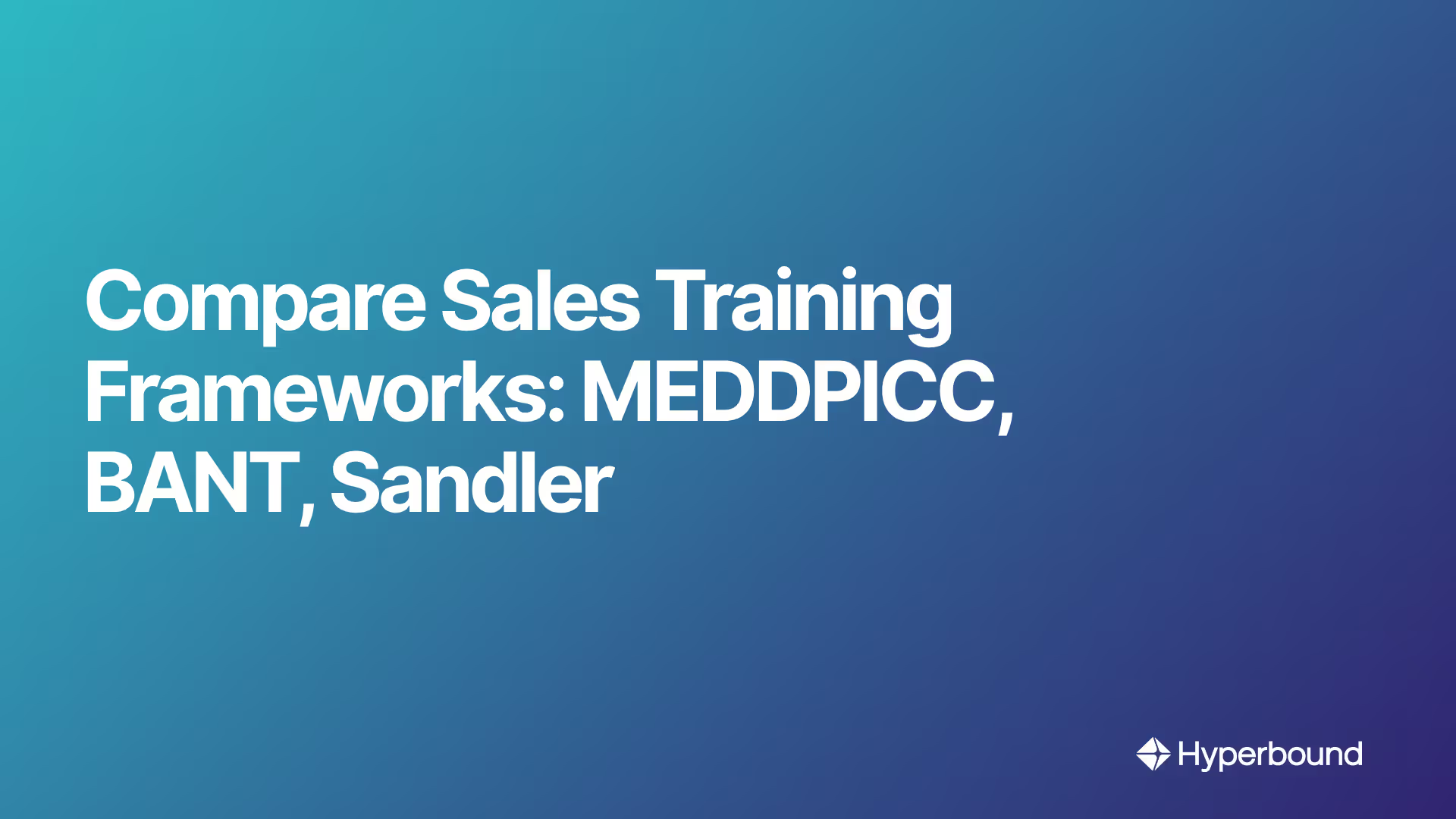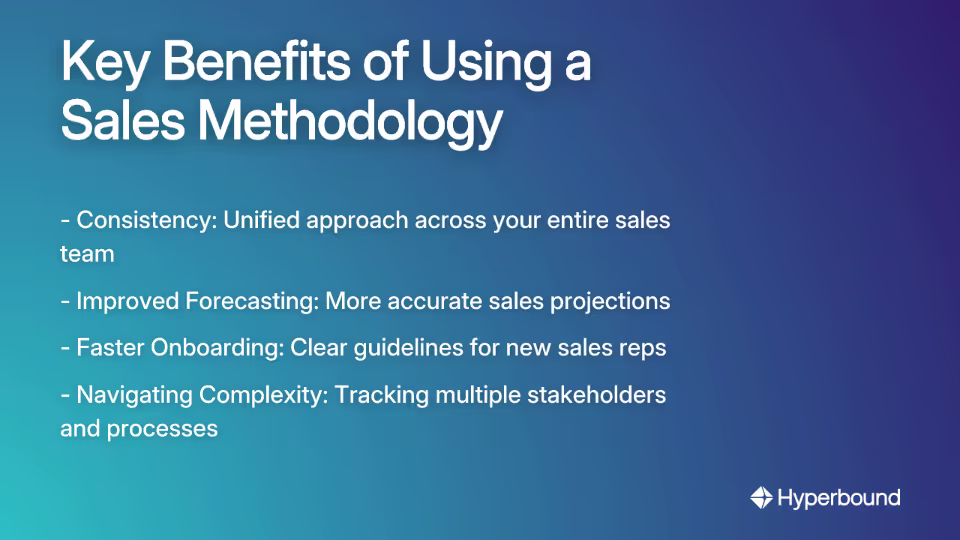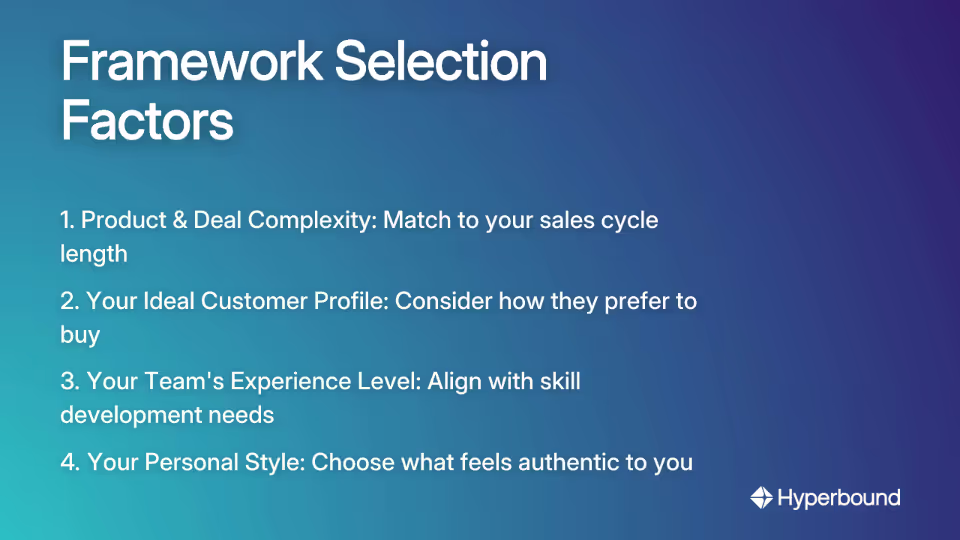
You've landed a role in enterprise sales, and suddenly you're drowning in acronyms. MEDDPICC? BANT? Sandler? Your colleagues throw these terms around like everyone was born knowing them, while you smile and nod, secretly Googling under the table. If this sounds familiar, you're not alone.
"I'm feeling nervous about starting my new role in enterprise sales," confessed one sales professional on Reddit. "I understand individual sales elements but struggle with overall execution."
The truth is, stepping into enterprise sales without a structured methodology is like navigating a foreign city without GPS. You might eventually reach your destination, but you'll waste time, miss opportunities, and probably develop an impressive collection of stress-induced gray hairs along the way.
This guide cuts through the noise. We'll break down three powerful methodologies—BANT, Sandler, and MEDDPICC—to help you understand their strengths and ideal applications. By the end, you'll have a clear framework for choosing the right one for your product, market, and personal sales style.
Why You Need a Sales Methodology (And Not Just Wing It)
Before diving into the frameworks, let's address a fundamental question: Why bother with a formal methodology at all?
The data speaks for itself. According to the Sales Enablement Collective, 32% of sales teams report wasting time on unqualified leads—a problem that proper qualification frameworks directly address. Beyond efficiency, a structured approach delivers several critical benefits:
- Consistency: Everyone on your team follows the same playbook, making it easier to share best practices and predict outcomes.
- Improved Forecasting: When you follow a systematic process, your sales projections become significantly more accurate.
- Faster Onboarding: New reps can get up to speed quickly with clear guidelines to follow. For example, platforms like Hyperbound allow reps to practice new methodologies in realistic AI roleplays, dramatically shortening their ramp time.
- Navigating Complexity: Enterprise deals involve multiple stakeholders, long timeframes, and complex buying processes. A methodology helps you track all moving parts.

Now, let's examine our contenders.
BANT: The Classic Qualifier
Budget, Authority, Need, Timeline—this straightforward framework has been qualifying leads since IBM created it in the 1950s.
How BANT Works
BANT functions as a quick qualification checklist:
- Budget: Does the prospect have money allocated to solve this problem?
- Authority: Are you talking to the person who can sign off on the purchase?
- Need: Does the prospect have a problem your solution can solve?
- Timeline: When do they plan to implement a solution?
A typical BANT conversation might include questions like: "Can you walk me through your budgeting process for solving challenges like this?" or "Who will be the primary decision-maker for implementing a solution like ours?"
BANT's Strengths and Limitations
Pros:
- Simple and intuitive—easy to remember and implement
- Quickly identifies obviously unqualified leads
- Perfect for high-volume sales environments
Cons:
- Too transactional for complex sales cycles
- Assumes a single "Authority," which rarely exists in enterprise sales
- As one Reddit user bluntly put it: "BANT is so outdated that it's not even a punch line anymore" for complex enterprise deals.
Who Should Use BANT?
BANT works best for:
- Straightforward products with clear value propositions
- SMB (small and medium business) markets
- High-volume sales environments where quick qualification is critical
- Teams with less experienced sales representatives
Sandler Selling System: The Consultative Partner
While BANT asks "Is this prospect qualified?", the Sandler Selling System asks "How can I build trust and uncover the prospect's true needs?" Developed by David Sandler in 1967, this methodology reframes sales as a consultative partnership.
How Sandler Works: The Submarine Process
Sandler uses a "submarine" metaphor with distinct compartments representing each phase of the sales process:
- Bonding and Rapport: Build genuine connection before diving into business.
- Up-Front Contract: Set mutual expectations for the conversation.
- Pain: Uncover the prospect's business and personal pain points.
- Budget: Discuss investment early and openly.
- Decision-Making Process: Map out how and who decides.
- Fulfillment: Present a solution that directly addresses the discovered pain.
- Post-Sell: Solidify next steps and prevent buyer's remorse.
The Sandler approach encourages salespeople to act as consultants rather than traditional sellers. You're actively looking for reasons to disqualify prospects if they're not a good fit, saving everyone time.
Sandler's Strengths and Limitations
Pros:
- Builds strong, trust-based relationships
- Excels at nurturing champions within organizations
- Uncovers potential objections early in the sales funnel
- Creates a buyer-led process that feels natural and non-pushy
Cons:
- Requires significant training investment—"It's about 6-7k and unfortunately I'd have to pay out of pocket," noted one Reddit user considering Sandler training. Modern AI coaching platforms offer a more scalable alternative, allowing teams to practice and adopt methodologies without the high cost of external seminars.
- Time-intensive approach not suited for high-volume sales
- Less structured for validating complex enterprise requirements
Who Should Use Sandler?
Sandler works best for:
- Complex B2B sales requiring deep customer relationships
- Solution selling where understanding pain points is crucial
- Sales professionals who naturally gravitate toward consultative approaches
- Organizations willing to invest in comprehensive training
MEDDPICC: The Enterprise Powerhouse
If BANT is a checklist and Sandler is a conversation guide, MEDDPICC is a comprehensive battle plan for complex enterprise sales. This rigorous qualification methodology helps sales teams navigate deals with multiple stakeholders, formal procurement processes, and long sales cycles.
What is MEDDPICC?
MEDDPICC stands for:
- Metrics: Quantifiable gains the prospect expects (ROI)
- Economic Buyer: The C-Suite or executive with ultimate spending authority
- Decision Criteria: Formal criteria for evaluating solutions
- Decision Process: Step-by-step buying process
- Paper Process: Legal and procurement requirements
- Identify Pain: Business challenges driving the purchase
- Champion: Your internal advocate
- Competition: Direct competitors and the status quo
"What is the difference between MEDDIC and MEDDPICC?" is a common question. The original MEDDIC framework evolved into MEDDPICC by adding two critical components: Paper Process and Competition. These additions make it more robust for today's complex enterprise sales environment.
MEDDPICC's Strengths and Limitations
Pros:
- Provides unparalleled structure for navigating multi-threaded deals
- Creates a comprehensive buyer map for complex organizations
- Dramatically improves forecast accuracy
- "Was a game changer for me," reported one enterprise sales professional on Reddit
Cons:
- Complex and time-consuming to implement fully
- Can feel overly rigid for smaller or less formal sales cycles
- Requires disciplined documentation and process adherence. Ensuring the whole team applies such a rigorous framework consistently is a major challenge that requires dedicated practice and coaching.
Who Should Use MEDDPICC?
MEDDPICC works best for:
- Enterprise sales with 5+ decision-makers
- High-value deals with long sales cycles
- Complex solution selling requiring extensive validation
- Organizations selling to enterprises with formal procurement processes
At a Glance: MEDDPICC vs. BANT vs. Sandler
FeatureBANTSandler Selling SystemMEDDPICCCore FocusQuick Lead QualificationConsultative Relationship & Pain DiscoveryRigorous Opportunity QualificationSeller's RoleQualifierConsultant / AdvisorStrategist / Deal ManagerBest ForHigh-volume, simple sales (SMB)Complex, relationship-driven B2B salesLarge, multi-stakeholder enterprise salesKey StrengthSpeed and SimplicityBuilding Trust & Disqualifying EarlyAccuracy and PredictabilityPrimary GoalFind "sales-ready" leadsUncover deep needs and build partnershipsWin complex deals methodically

How to Choose Your Framework: A Practical Guide
Choosing a methodology isn't about which is "best," but which is the best fit for your specific situation. Consider these key factors:

1. Product & Deal Complexity
If you sell a straightforward product with a short sales cycle and few decision-makers... start with BANT.
If you sell a complex solution where understanding the customer's business pain is crucial for success... use the Sandler System.
If you sell to large enterprises with formal procurement, multiple departments (multi-threaded), and long contract negotiations... you need MEDDPICC.
2. Your ICP (Ideal Customer Profile)
How do your customers typically buy? Do they expect a quick, transactional process or a deep, consultative partnership? Match your methodology to their expectations and process planning needs.
Enterprise customers with formal procurement processes will respond better to the structured approach of MEDDPICC, while smaller businesses may appreciate the relationship-building focus of Sandler.
3. Your Team's Experience Level
New sales teams often benefit from the simplicity of BANT, while experienced enterprise sellers can leverage the sophistication of MEDDPICC for solution mapping and validating complex requirements.
4. Your Personal Style
"I want to build a style and have consistency now that I have transitioned to an AE from a BDR," shared one sales professional on Reddit. While you should adapt to the deal, your natural strengths can guide your primary framework choice.
Are you naturally analytical and detail-oriented? MEDDPICC might align with your strengths. Do you excel at building relationships? The Sandler approach could feel more authentic to your style.
Conclusion: From Confusion to Confidence
The enterprise sales maze doesn't have to be overwhelming. BANT offers speed and simplicity, Sandler provides depth and relationship-building, and MEDDPICC delivers structure for navigating complexity.
Remember what one experienced sales professional shared: "Most methodologies are just frameworks and share a lot of the same premise." The best sales professionals learn the principles and adapt them to the situation, sometimes blending elements from different systems. The challenge is ensuring your team can practice and master these custom talk tracks.
Many successful enterprise sales teams use BANT for initial qualification, elements of Sandler for nurturing champions and uncovering pain points, and MEDDPICC for managing the overall enterprise sales process.
Committing to a methodology provides the structure you need to move from feeling nervous and overwhelmed to feeling confident and in control of your sales process. It turns complex enterprise sales from a confusing maze into a clear path to success.
The key is to start somewhere. Choose a framework that aligns with your current needs, implement it consistently, and refine your approach as you gain experience. Your sales methodology should be a living tool that evolves with your growth—not a rigid formula that limits your potential.
So which will you choose? The simplicity of BANT, the relationship depth of Sandler, or the enterprise rigor of MEDDPICC? The answer begins with understanding your unique sales environment and goals.

Frequently Asked Questions
What is a sales methodology and why is it important?
A sales methodology is a structured framework that guides salespeople through each stage of the sales process, ensuring a consistent and effective approach. It is crucial for enterprise sales because it helps manage complex deals, improve forecast accuracy, eliminate wasted time on unqualified leads, and accelerate the onboarding of new reps.
What are the main differences between BANT, Sandler, and MEDDPICC?
The main differences lie in their core focus and ideal use case. BANT is a simple qualification checklist (Budget, Authority, Need, Timeline) best for high-volume sales. The Sandler System is a consultative approach focused on building trust and uncovering deep-seated pain points. MEDDPICC is a rigorous, comprehensive framework designed to manage and win complex, multi-stakeholder enterprise deals.
When should I use the BANT sales methodology?
You should use BANT for straightforward sales processes where speed and efficiency are the top priority. It is most effective in high-volume environments, when selling to small and medium businesses (SMBs), or for less experienced teams who need a simple framework to quickly qualify leads.
Why is MEDDPICC considered ideal for complex enterprise sales?
MEDDPICC is considered ideal for complex enterprise sales because it provides a detailed roadmap for navigating long sales cycles, multiple decision-makers, and formal procurement processes. By systematically tracking Metrics, the Economic Buyer, Decision Criteria, and other key elements, it dramatically improves forecast accuracy and strategic alignment.
What does the acronym MEDDPICC stand for?
MEDDPICC stands for Metrics, Economic Buyer, Decision Criteria, Decision Process, Paper Process, Identify Pain, Champion, and Competition. Each component represents a critical piece of information you must validate to successfully manage and close a complex enterprise opportunity.
How do I choose the right sales methodology?
To choose the right methodology, evaluate your specific situation based on four factors: your product and deal complexity, your ideal customer's buying process, your team's experience level, and your personal sales style. The best methodology is one that fits your unique context, not a one-size-fits-all solution.
Can you combine different sales methodologies?
Yes, absolutely. Experienced sales professionals often blend elements from different methodologies to create a custom approach. For example, a team might use BANT for initial lead qualification, Sandler techniques to build rapport and uncover pain, and MEDDPICC to manage the qualified opportunity through the complex enterprise sales cycle.
Book a demo with Hyperbound
.png)













